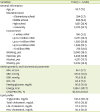1. Ha KH, Kwon HS, Kim DJ. Epidemiologic characteristics of dyslipidemia in Korea. J Lipid Atheroscler. 2015; 4:93–99.

2. Korea National Statistical Office. Prevalence of hypercholesterolemia: sex, age 30 and over. 2016. cited 2018 October 30. Available from
http://kosis.kr/index/index.do.
3. Aekplakorn W, Taneepanichskul S, Kessomboon P, Chongsuvivatwong V, Putwatana P, Sritara P, Sangwatanaroj S, Chariyalertsak S. Prevalence of dyslipidemia and management in the Thai population, national health examination survey IV, 2009. J Lipids. 2014; 2014:249584.

4. Pongchaiyakul C, Hongsprabhas P, Pisprasert V, Pongchaiyakul C. Rural-urban difference in lipid levels and prevalence of dyslipidemia: a population-based study in Khon Kaen province, Thailand. J Med Assoc Thai. 2006; 89:1835–1844.
5. Joshi SR, Anjana RM, Deepa M, Pradeepa R, Bhansali A, Dhandania VK, Joshi PP, Unnikrishnan R, Nirmal E, Subashini R, Madhu SV, Rao PV, Das AK, Kaur T, Shukla DK, Mohan V. ICMR-INDIAB Collaborative Study Group. Prevalence of dyslipidemia in urban and rural India: the ICMR-INDIAB study. PLoS One. 2014; 9:e96808.

6. Pan L, Yang Z, Wu Y, Yin RX, Liao Y, Wang J, Gao B, Zhang L. China National Survey of Chronic Kidney Disease Working Group. The prevalence, awareness, treatment and control of dyslipidemia among adults in China. Atherosclerosis. 2016; 248:2–9.

7. Ahn Y, Park YJ, Park SJ, Min H, Kwak HK, Oh KS, Park C. Dietary patterns and prevalence odds ratio in middle-aged adults of rural and mid-size city in Korean Genome Epidemiology Study. Korean J Nutr. 2007; 40:259–269.
8. Ministry of Health and Welfare, Korea Centers for Disease Control and Prevention. The 6th Korea National Health and Nutrition Examination Survey (KNHANES VI). Cheongju: Korea Centers for Disease Control and Prevention;2015.
9. Jee SH, Jang Y, Oh DJ, Oh BH, Lee SH, Park SW, Seung KB, Mok Y, Jung KJ, Kimm H, Yun YD, Baek SJ, Lee DC, Choi SH, Kim MJ, Sung J, Cho B, Kim ES, Yu BY, Lee TY, Kim JS, Lee YJ, Oh JK, Kim SH, Park JK, Koh SB, Park SB, Lee SY, Yoo CI, Kim MC, Kim HK, Park JS, Kim HC, Lee GJ, Woodward M. A coronary heart disease prediction model: the Korean Heart Study. BMJ Open. 2014; 4:e005025.

10. Committee for the Korean Guidelines for the Management of Dyslipidemia. 2015 Korean Guidelines for the Management of Dyslipidemia: executive summary (English translation). Korean Circ J. 2016; 46:275–306.
11. Hu FB. Dietary pattern analysis: a new direction in nutritional epidemiology. Curr Opin Lipidol. 2002; 13:3–9.

12. Newby PK, Muller D, Tucker KL. Associations of empirically derived eating patterns with plasma lipid biomarkers: a comparison of factor and cluster analysis methods. Am J Clin Nutr. 2004; 80:759–767.

13. Lee J, Kim J. Association between dietary pattern and incidence of cholesterolemia in Korean adults: the Korean Genome and Epidemiology Study. Nutrients. 2018; 10:E53.

14. Kim Y, Han BG; KoGES group. Cohort profile: The Korean Genome and Epidemiology Study (KoGES) Consortium. Int J Epidemiol. 2017; 46:e20.

15. Linseisen J, Kesse E, Slimani N, Bueno-De-Mesquita HB, Ocké MC, Skeie G, Kumle M, Dorronsoro Iraeta M, Morote Gómez P, Janzon L, Stattin P, Welch AA, Spencer EA, Overvad K, Tjønneland A, Clavel-Chapelon F, Miller AB, Klipstein-Grobusch K, Lagiou P, Kalapothaki V, Masala G, Giurdanella MC, Norat T, Riboli E. Meat consumption in the European Prospective Investigation into Cancer and Nutrition (EPIC) cohorts: results from 24-hour dietary recalls. Public Health Nutr. 2002; 5:1243–1258.

16. Kim J, Jo I, Joung H. A rice-based traditional dietary pattern is associated with obesity in Korean adults. J Acad Nutr Diet. 2012; 112:246–253.

17. Hong S, Song Y, Lee KH, Lee HS, Lee M, Jee SH, Joung H. A fruit and dairy dietary pattern is associated with a reduced risk of metabolic syndrome. Metabolism. 2012; 61:883–890.

18. Son SM, Hoe KY. Salt intake and nutritional problem in Korean. Korean J Community Nutr. 2002; 7:381–390.
19. Yoon YS, Oh SW. Sodium density and obesity; the Korea National Health and Nutrition Examination Survey 2007–2010. Eur J Clin Nutr. 2013; 67:141–146.

20. Jung S, Kim MK, Shin J, Choi BY, Lee YH, Shin DH, Shin MH. High sodium intake and sodium to potassium ratio may be linked to subsequent increase in vascular damage in adults aged 40 years and older: the Korean multi-rural communities cohort (MRCohort). Eur J Nutr. 2019; 58:1659–1671.

21. Choi J, Moon HK. Comparison of dietary patterns by Sex and urbanization in different economic status. Korean J Community Nutr. 2008; 13:346–358.
23. Song S, Song WO, Song Y. Dietary carbohydrate and fat intakes are differentially associated with lipid abnormalities in Korean adults. J Clin Lipidol. 2017; 11:338–347.e3.









 PDF
PDF ePub
ePub Citation
Citation Print
Print



 XML Download
XML Download